As we leave, the journalist in me wants to know how Victor felt about all this. How his students felt who did the March of Death the week before. I ask Loreta to ask him. His response is bland and avoids the “feeling” question. I ask this question a few times and each time he says nothing. I tell Loreta, insistently and in a very American Jew pushy way she later chides me about, what do the children feel? The Victor finally relents and says “They feel pity for the Jews and anger at the Germans; they feel pity for the Lithuanians who were killed by the Soviets, and anger at the Soviets.” Left out of the equation, part of the silence is any consideration of the people who actually did the killings—the grandparents and great grandparents of the school children. Everyone has their own narrative that implicates others and exonerates oneself. The official stance of the Lithuanian government is to make this moral equation between the Soviets and the Germans—both equal tormenters of Jews and Christians. I thank the high school teacher for his frankness. He smiles and says he is honored that I have come to his small town to find my family. And he smiles, for the first time telling me that this summer he is going to Ukraine to find the grave of his grandfather who was taken as a prisoner of war to a Soviet prison where he died. We share this. We forget that his people killed my people, and we shake hands farewell.
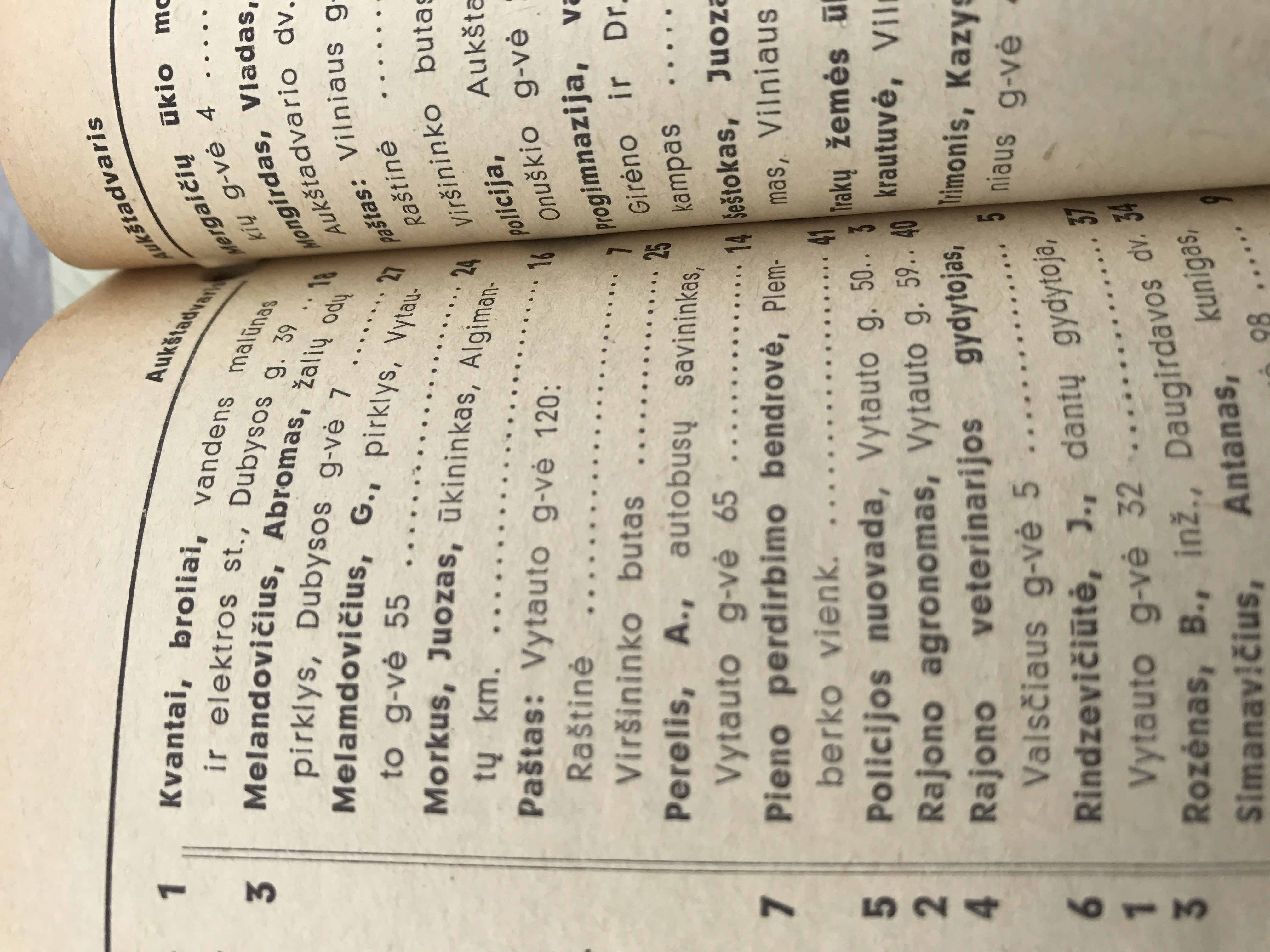
Loreta now pulls out a beaten up old Kaunas telephone directory from 1940. It lists four Melondovichs: two who live in Ariogala and two in Kaunas. She points out that to have a phone in that era and place meant you had some money. Their professions included merchant, paint supplier, upholstery materials purveyor. These are professions I feel no excitement about. No writers or actors, no teachers or opera singers. But they are relatives and Jewish tourism demands we pursue all leads. We go down a side road in town where there are chickens in the front yards and a farm across the road. The number for the house we are looking for is no longer there, and a couple of postwar concrete cottages occupy the location. We stop the car and a woman immediately runs out of one of the houses. Loreta tells me that the locals don’t get much drive-by activity and they are immediately suspicious. Loreta gets out to assuage her fears and get information. Yes, the woman says, this was the property of Jews—they remember that. But of course, the woman says, there are none now.
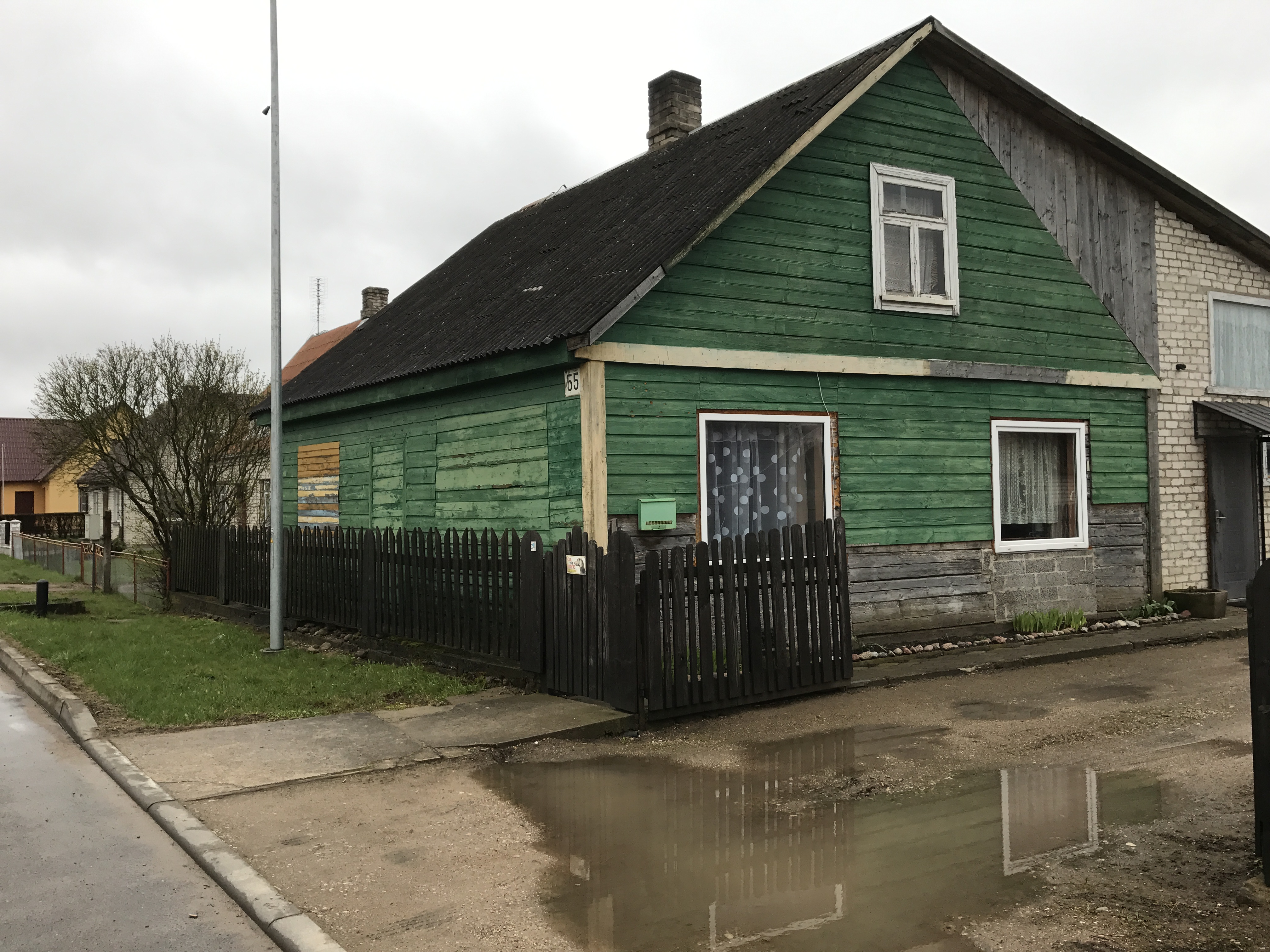
We backup the car and head to the second address. We are counting the numbers and we arrive at a green-painted wooden house that looks occupied but closed up. I get out and walk around it. Some family member, distant cousins perhaps, lived here till 1941 when they were taken from the house and perished in the pit. The house is small and grim. Across the street another one like it sits in near ruin.
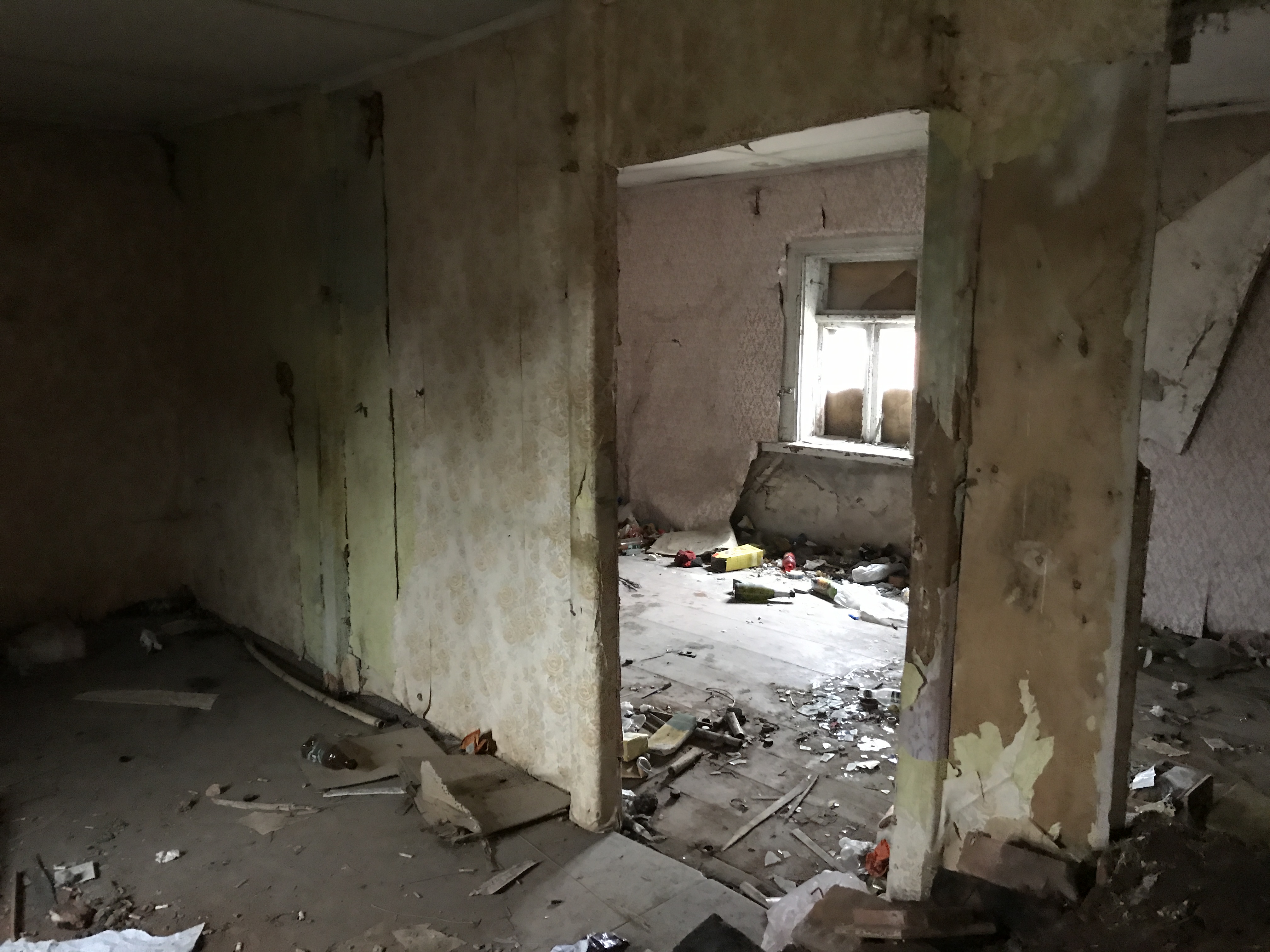
I walk inside the latter. There are three rooms filled with rubble, broken linoleum on the floor, scattered domestic items, a ladder akimbo. In the back yard a shattered and collapsed hut. But it reminds me that this happened not so long ago. They had utensils and flooring that were modern. My brother was two years old when this happened; my parents had been married for three years. My Dad was 43, my Mom 30. My uncles and aunts were all alive. This isn’t like visiting the remote past. I have to remember that I’m not set apart from these events by the protective buffer of a long century. Again, the act of imagination required by Jewish tourism. What was it like then? Who lived here in their ordinary and unremarkable lives, made remarkable by the actions of history and individuals?
Loreta and I move on to the most unimaginable space—the Ninth Fort. Kaunas was surrounded by nine forts built under the tsars. It was to this last fort, that Germans brought 50,000 Jews to be killed by bullet. As one approaches the area, the first and most dramatic thing one sees rising massively into the air is a dense and yet ethereal memorial built out of concrete and designed by the sculptor A. Ambraziunas in 1984. Loreta tells me it was designed in the “brutalist” style—a style I know well since my university is built by Walter Netch, one of the foremost proponents of brutalism. The style takes its name from concrete brut, a type of material used in the construction. But in most cases the style is in fact brutal, and the memorial is brutal as well, both in design and in concept. It launches itself 100 feet high in three separate crag-like sections that, upon a closer look, seem to be composed of human forms emerging from the earth and ultimately reaching up to the sky. It is imposing on this dark, rainy, day. I don’t need to see it up close; it’s so massive. Walking up to the killing pit, one tries to imagine how 50,000 bodies could be under such a field. Jews from the ghetto in Kaunas were shot here, but there were Jews brought from German and Austrian urban centers as well as a group from France. All were told they were being relocated. They came by train and then walked the 4 miles from the city center to the Ninth Fort. Their walk took them over the main bridge and through the ghetto. While the Jews in the ghetto initially refused to believe that a massive shooting was going on at the fort, after a while the word got out. So the Jews in the ghetto would yell to the urban Jews, dressed in their best clothing with luxurious valises, that they were going to be killed. Many didn’t listen, but others tried to resist and struggled with the guards for their guns. Loreta tells me that the German Jews were the only ones who had tried to resist, although resistance was futile. The collected Jews were locked into compounds for a few days and then they would be brought to the pits where they had to remove their clothing and were killed. The Nazis would rev the engines of their large trucks near the compound so the remaining Jews wouldn’t hear the shots.
I had had enough of death, of the dark tourism. I was cold, tired, and saturated with the horror. Loreta suggested we could go to the museum on the premises, but I said, “Let’s go.” I had the luxury of fleeing while my counterparts did not.
After lunch at a very large shopping mall, we toured the old city. Loreta switched on her guide voice listing dates, sizes, denominations, and the like. She pointed out a curved wide street where one of the Melondovichs had lived, but the street name was changed as was the numbering. This was again an abstract knowing. Arrow points to location. Only the ground and the earth remember. The old city is worth a visit by anyone. Filled with shops and well-kept low buildings, it could be on any world heritage tour. Loreta, however, has information that other tour guides do not. This used to be a kosher butcher. This used to be a yeshiva. This used to be. This used to be. I’m not really listening now. My esemplastic imagination, as Coleridge called the ability of the mind to reach out into the world and shape it, is no longer plastic. I’ve solidified into a tired tourist, which is its own source of shame and humiliation. How short is my attention span for horror? How quickly one habituates. I remember the scandalous comment made by Vice President Spiro Agnew when touring a ghetto in the United States: “When you’ve seen one slum, you’ve seen them all.”
But Loreta is not stoppable as a guide. There are a few more things to be seen. A high point from which to see the city as a panorama. The house of the Japanese ambassador Sugihara who before the German invasion granted thousands of visas to Jews so they could emigrate to Japan.
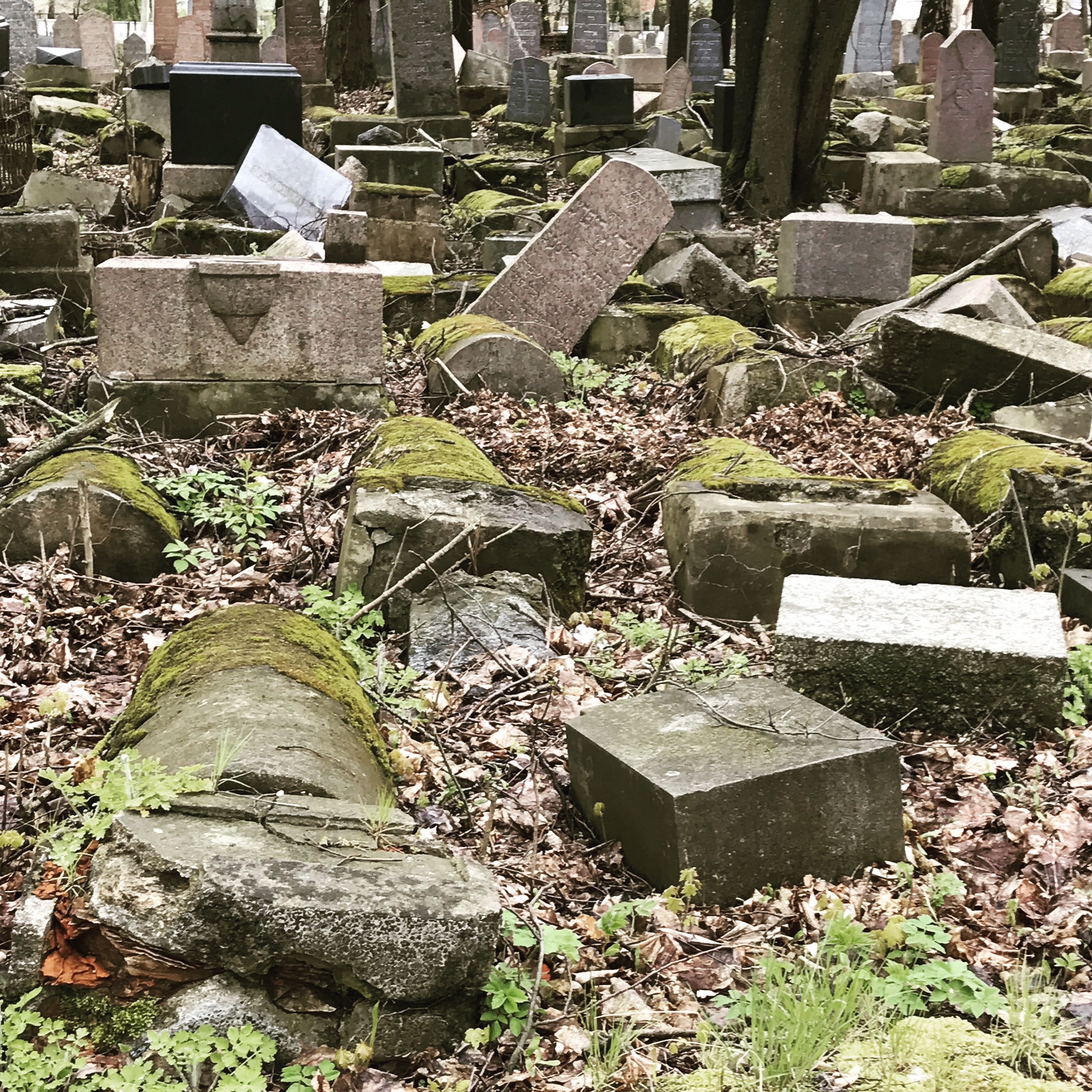
And then the Jewish cemetery of Kaunas. Loreta warns that some people don’t react well to it. As we drive up to it, she notes with mild surprise that it looks better than when she last came. She says that some students have come and cut down the overgrowth. What meets the eye is a chaos of stone. The graves here have the usual vertical tombstones, many toppled, but the graves themselves are burdened with massive semi-cylindrical stone covers that span the length of the grave, perhaps to prevent vandalism. The cemetery, despite the clipping of vines, is a mess of moss-covered memorials, all pushed and fallen in every direction. The graves, very close to each other, have collapsed in haphazard ways and look like the bodies of the murdered Jews piled up on each other. Cemeteries can only survive if the living look after the dead. With no Jews in Lithuania, the dead will have to take care of themselves. And that they cannot do very well. The helter-skelter here reveals, in its silent cacophony, more than all of Loreta’s data can account for. I don’t need to see more.
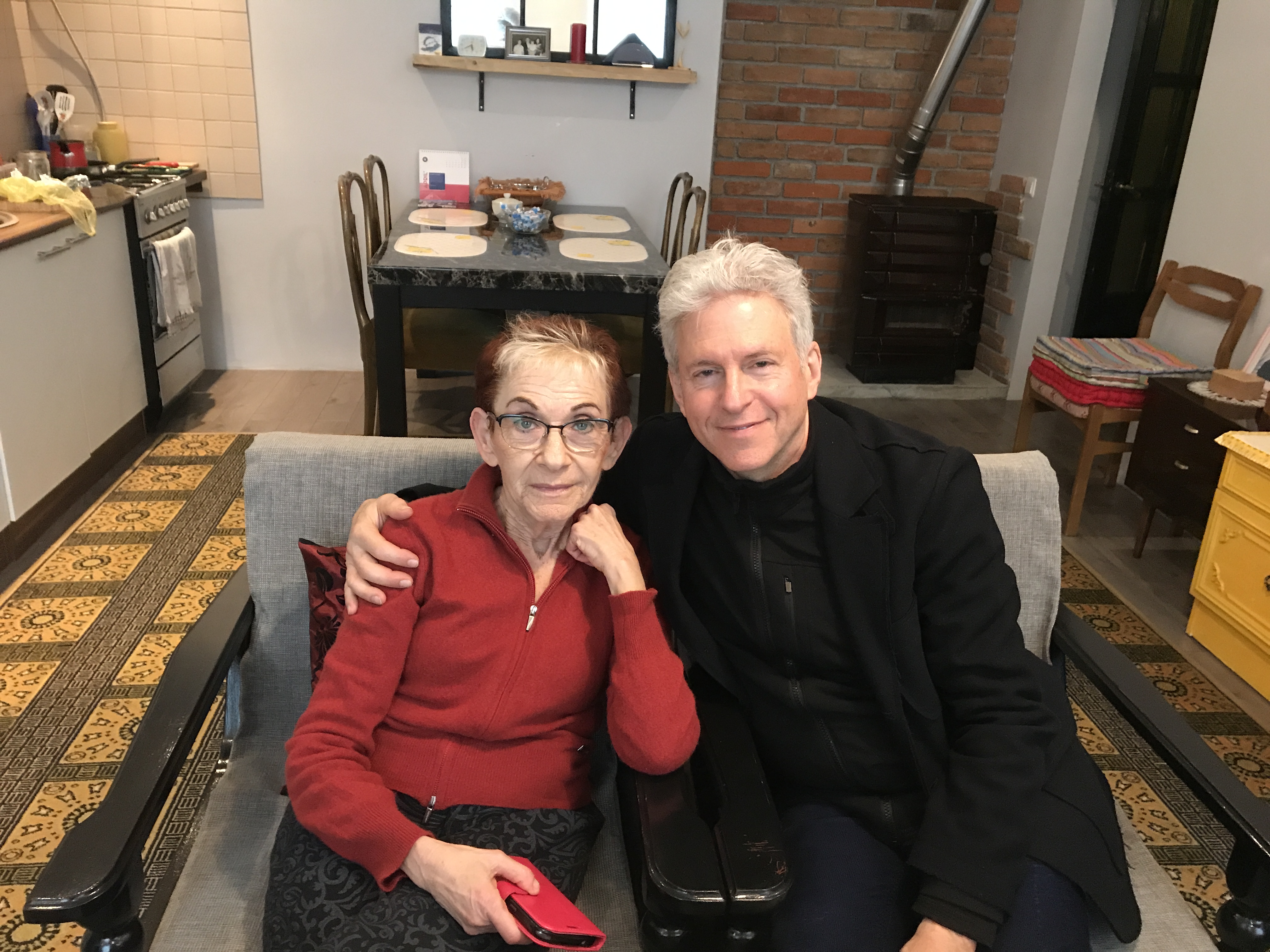
Our last stop is to visit a Jewish woman named Bella Shirin. She lives in an apartment loaned to her by a Lithuanian professor who thought I should meet her. So far, in Lithuania, I haven’t met a single Jew. I’ve talked to Bella on the phone, and she sounds like she’s in her 80’s. I’ve been told by the professor that she knows a lot about the wartime period, so I assume she lived in the ghetto during the occupation. Loreta warns me not to ask too many questions. Don’t ask how old she is, don’t ask how many children she has. (I’ve already asked those things of Loreta, who clearly is now telling me I shouldn’t have).
Bella lives in a courtyard off the main street. That yard was one in which many Jews lived before the war, and Vytenis Jakas, a local artist living there, has transformed the bland and rundown courtyard into an art exhibit. The walls are covered with paintings of the those who lived there, cats who lived there, and for some reason icons like Charlie Chaplin and Frieda Kahlo. We walk up a dark set of stairs and the door opens as the reek of stale cigarette smoke greets us. Bella is a very small, thin, old woman with sharp features, very wrinkled, short dyed reddish hair cut in pixie style, and a warm smile. She offers me wine, and immediately tells me her age and the number of children she has. She’s a Jew like me. I cast a told-you-so look at Loreta. We Jews like information. She’s only three years older than me, but she looks at least twenty years my senior. She’s been through a lot. Her parents were in the Kaunas ghetto and then they were shipped off to Dachau, where they managed to survive. When they were liberated, they returned to Kaunas, but fairly quickly moved to Israel. Bella now, after all these years, has returned. I ask her about the ghetto, but she prefers not to talk about “heavy” themes. She is an optimist and has returned with a respect for forgiveness, art, and culture. She believes that Lithuania’s best times are to come, and she’s been dubbed the “Ambassador” of Lithuania for her efforts to heal, forgive, forget, and look forward. As she says, “When I look around at the Lithuanians now, I can’t blame them. They weren’t alive then. And it’s better to forgive than dwell on the past.” She tells of a group of Jews from Kaunas living in Israel. “All they do is remember the horrors. I don’t want to do that.”
I drink my Lithuanian wine and Bella takes some egg-colored liquor for herself, which she nurses with a certain relish. Loreta has brought some kasha kugel she made at home. We all sit around eating and drinking. Bella asks me my astrological sign. She is a great believer, noting that the most important thing is to get your time of birth to the second. On the one hand, she seems like a survivor who has endured, on the other hand a bit of a flighty kook. In her life she had been an actress in Jewish theater and also worked for banks in investment. To confirm the stereotype, she says knowingly that she was very good at investing.
I leave her and Loreta. As I part from Loreta, who told me that she recently gave a tour of Kaunas to fellow tour guides who asked what she characterized as “a lot of stupid questions,” I ask her, half jokingly, if I asked too many stupid questions. She answered, without a smile, “Not too many.” I pay her in cash and we part. She’s been a font of information but a font without healing powers.
For some unknown reason, I go to see a performance of a 1920’s operetta Madame Pompadour in the 19th century jewel-box state theater. I don’t have time to change, and I walk in with my rain-soaked sneakers. Most of the Lithuanians are dressed up. This is a special occasion for them. The operetta tells the story of a famous 18th century woman of loose morals. The theater company is dolled up in silly costumes of the era and there is much singing and dancing and tomfoolery. Since the production is in Lithuanian without subtitles, I’m a bit lost. But you can’t really be lost with buxom blonde maids singing and dancing while leering captains and noblemen make exaggerated gestures of desire. The audience is completely taciturn. They don’t laugh. They don’t clap. The harder the actors work, the less the audience responds. The only time there was a collective guffaw was when a man came out dressed as a woman. This cool audience reaction, which I saw at the opera in Vilnius, led me to speculate on the inner lives of the residents. Or perhaps it was the inner lives not being reflected in the public life. But this was a country occupied so many times in history. So many lives lost in various invasions, defenses, assaults. Could it be that, as I kept hearing, it was better not to talk too much? Not to show too much? How much pain and repression can a people bear? The silence around the Jewish question, Loreta’s finger wagging about my inquisitive mind, the haunted dead floating above the light-hearted and silly operetta, all said something powerful.
In my hotel, a mustachioed man in the hallway of hotel hears me speaking in English to the receptionist. He smiles and says, “You from the UK?” I tell him I’m from the US. He says, “I’m from Wales, but came here to find my family in 1998. We’ve been visiting them every year since. How about you?” I tell him that my grandfather came from Kaunas. He breaks into a big smile “Did you find your family?” There is a long silence in my mind. Should I say anything? I say “I’m Jewish.” He smiles benignly, as if to say “that’s alright.” He clearly is unfamiliar with the history here. So I add, “They killed all the Jews.” Without missing a beat, as if he really couldn’t process that tidbit of history, he says “Well, have a nice visit.” It’s not only the Lithuanians who maintain the silence.
Jewish tourism: When you tell people about your experiences, about your situation, it ends the conversation. Holocaust, kill pits, bullets in the head, babies smashed against trees—it’s a buzz kill. Jewish tourism makes the Ancient Mariner’s story a happy cartoon travelogue. You become a person with a horrible story no one wants to hear, yet to say nothing seems like an act of complicity. To say something is an offense to polite conversation.
The next morning I decided on a last run along the Naris River. It was early morning and cold, but the dreary overcast skies were gone. A clear bright sun was rising over the flourmills and granaries on the far bank. Along the riverside, fisherman were casting their lines, as my grandfather had, and waiting patiently. No one seemed to catch any fish. They were engaged in an activity that gave them pleasure and only occasionally produced anything of substance. It was easy to run from the center of the town to the countryside, the town being that small. Now there were small houses and farm buildings. As I ran, I passed a graffiti-covered wall that had a dramatic large image of a polar bear on an iceberg breaking up because of global warming. In its hand, the bear held a Popsicle of the same blue ice that was melting and only a fragment remained. The holocaust by bullet seemed far away. But the political urge to survive remained in the graffiti. Now it was climate change. People here, some people, cared about the plight of humanity. I wanted to think that some people back then had cared too. There were those who risked their lives, the Righteous Among the Nations (Yad Vashem) as they are now called. I had heard about such people risking their lives hiding Jews, taking Jewish babies out of the ghetto in potato sacks. The will to live, to survive, to help, runs as deep, I hope, as the urge to kill.
Before I left for Lithuania, my daughter Francesca, who has been concerned with justice from a young age, asked me, in regard to Trump’s ban on immigrants, would I be willing to hide a person who might be deported? It made me think. Would I? I’d like to say yes; I’d like to say that the innate sense of justice I cherish would expand and fill my being. But I could see myself also worrying about the consequences, and even just the reality of having a stranger at home. I think I would be able, but I can’t judge others who didn’t help. My complicity has not been tested in the ways that the parents and the grandparents of these quiet fishermen were.
As I ran back to Kaunas from the countryside, two large and beautiful swans lifted slowly off the river and flew into the distance. They seemed to say to me that one can rise above the pain of the past and seek the freedom of the dawn-lit skies.

